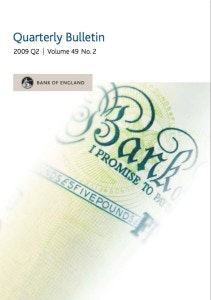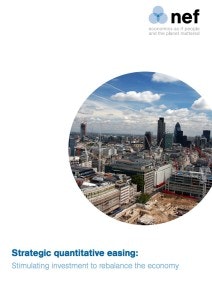How Quantitative Easing Works
Most of the money in our economy is created by banks when they make loans.

Most of the money in our economy is created by banks when they make loans. But in the aftermath of the financial crisis, banks stopped lending, and so stopped creating new money.
At the same time, people were still repaying their loans, meaning money was being ‘destroyed‘ and the total amount of money in the economy was shrinking. To counter this and to ‘replace’ the money that banks were destroying, the Bank of England created £445 billion of new money through a scheme called Quantitative Easing (QE). As the Governor of the Bank of England said at the time:
“[A] damaged banking system means that today banks aren’t creating enough money. We have to do it for them.”
– Sir Mervyn King, then-Governor of the Bank of England, speaking in 2012
How does Quantitative Easing work?
In the press, QE was generally presented as “The Bank of England prints money and lends this to banks so that they can increase their lending into the economy”, but this is completely inaccurate.
In reality, through QE the Bank of England purchased financial assets – almost exclusively government bonds – from pension funds and insurance companies. It paid for these bonds by creating new central bank reserves – the type of money that bank use to pay each other. The pension funds would sell the bonds to the Bank of England and in exchange, they would receive deposits (money) in an account at one of the major banks, say RBS. RBS would end up with the new deposit (a liability from it to the pension fund), and a new asset – central bank reserves at the Bank of England.
Quantitative Easing therefore simultaneously increased a) the amount of central bank money, which is used in the system that banks use to pay each other, and b) the amount of commercial bank money (deposits in the bank accounts of people and companies). Only the deposits can actually be spent in the real economy, as central bank reserves are just for internal use between banks and the Bank of England.
(See the further reading section below for a more in-depth explanation of the process).
Why was Quantitative Easing ineffective in boosting GDP?
The problem was that the money created through QE was used to buy government bonds from the financial markets (pension funds and insurance companies). The newly created money therefore went directly into the financial markets, boosting bond and stock markets nearly to their highest level in history. The Bank of England itself estimates that QE boosted bond and share prices by around 20% (Source). In theory, this should make people feel wealthier so that they spend more. However, 40% of the stock market is owned by the wealthiest 5% of the population, so while most families saw no benefit from Quantitative Easing, the richest 5% of households would have each been up to £128,000 better off (according to Strategic Quantitative Easing, p28, by the New Economics Foundation).
Very little of the money created through QE boosted the real (non-financial) economy. The Bank of England estimates that the first £375 billion of QE led to 1.5-2% growth in GDP. In other words, through QE it takes £375 billion of new money just to create £23-28bn billion of extra spending in the real economy. It’s incredibly ineffective, because it relies on boosting the wealth of the already-wealthy and hoping that they increase their spending. In other words, it relies on a ‘trickle down’ theory of wealth.
A far more effective way to boost the economy would have been for the Bank of England to create money, grant it directly to the government, and allow the government to spend it directly into the real economy. This is the approach we have advocated in our paper “Sovereign Money: Paving the Way for a Sustainable Recovery“, and pound for pound of stimulus, it would be many times more effective than Quantitative Easing.
Further Reading
Bank of England: Quantitative Easing

This 8 page paper from the Bank of England is extremely clear on the mechanics of QE and how the Bank of England expected it to have an effect on spending in the real economy.
New Economics Foundation: Strategic Quantitative Easing

This recent paper from the New Economics Foundation gives more technical detail on how QE was implemented, and assesses how effective it really was. It then proposes a way to redirect the QE money into the real economy. Download here